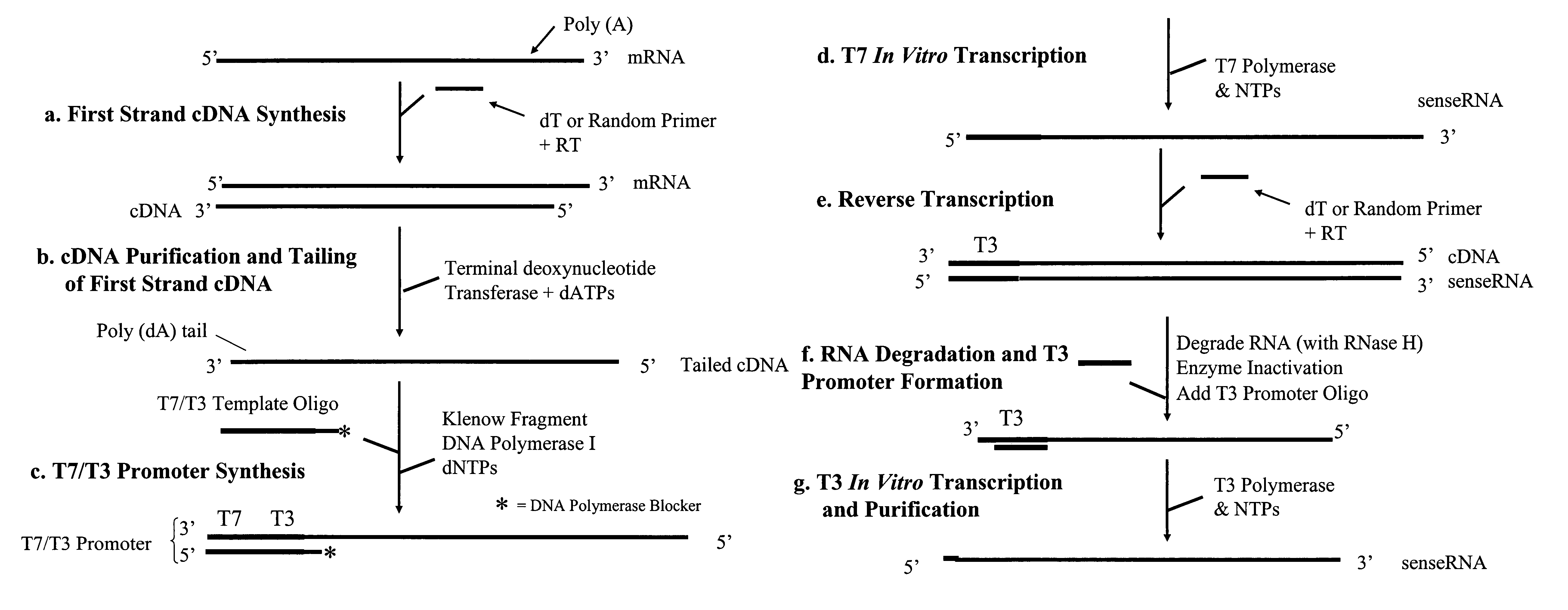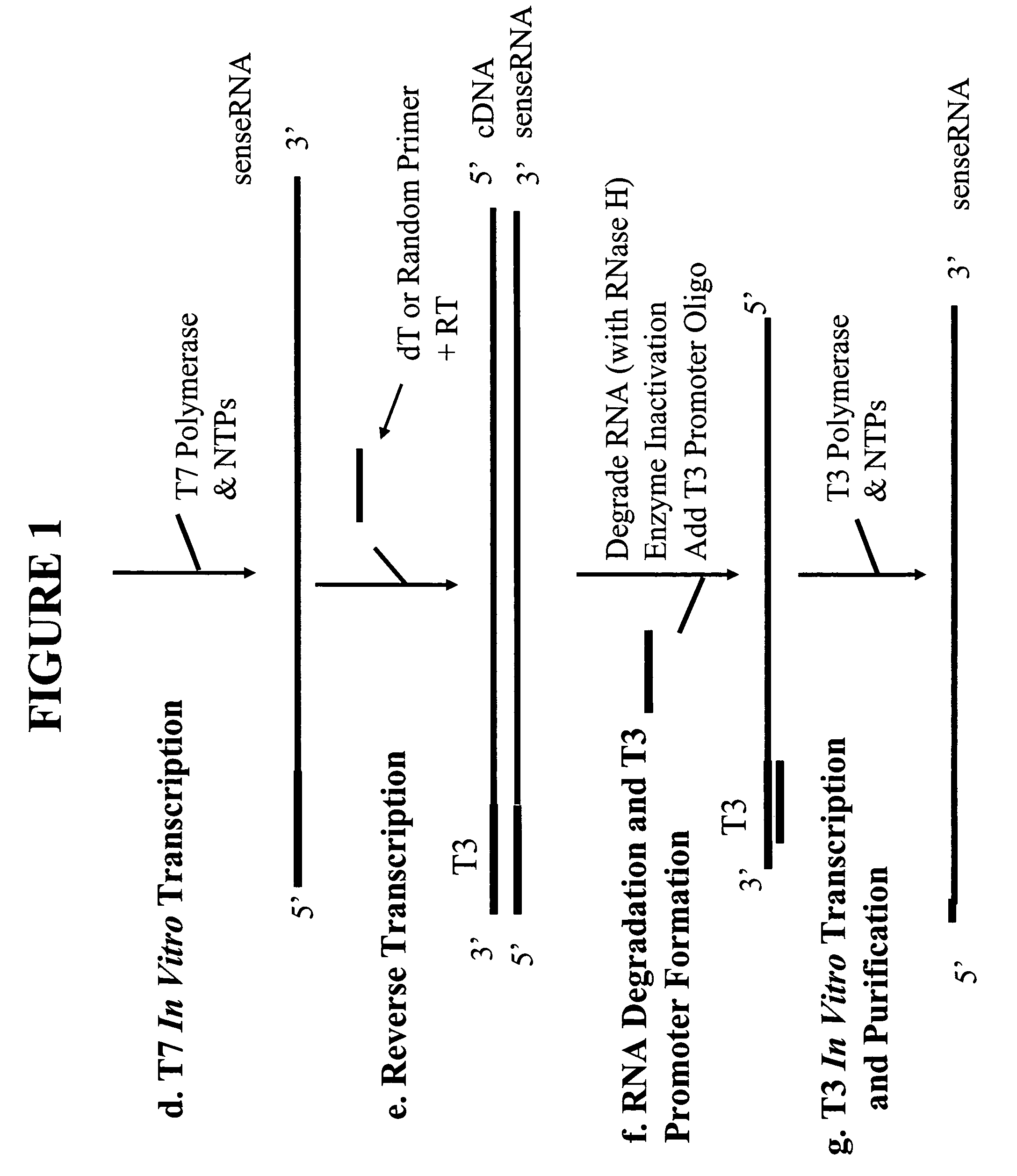Methods and kits for sense RNA synthesis
a technology of rna and synthesis kits, applied in the field of compositions and methods for synthesizing nucleic acid molecules, can solve the problems of large amounts of rna that are often not available, microarray expression analysis, and techniques that suffer from amplification bias, so as to increase the number and type of downstream assays
- Summary
- Abstract
- Description
- Claims
- Application Information
AI Technical Summary
Benefits of technology
Problems solved by technology
Method used
Image
Examples
example 1
[0049]First Strand cDNA Synthesis
[0050]For each RNA sample, purified using the RNAqueous® Kit (Ambion), the following RNA / primer mix was prepared on ice:[0051]1-8 μl total RNA (not exceeding 2 ng)[0052]2 μl first round oligodT sequence specific RT primer (50 ng / μl) (5′-TAC AAG GCA ATT TTT TTT TTT TTT TTT V-3′, where V=C, G or A deoxyribonucleotides; SEQ ID NO: 4)[0053]1 μl first round random sequence specific RT primer (2× by mass of RNA) (5′-TAC AAG GCA ATT NNN NNN NNN-3, where N=A, G, C or T deoxyribonucleotides at random; SEQ ID NO: 5)[0054]RNase-free water to 11 μl
[0055]The first round RT primers comprise a 5′ extension containing a specific nucleotide sequence that serves as binding sites for second round RT primers (see FIG. 2a). The RNA / primer mixture was heated at 80° C. for 10 minutes and immediately cooled on ice for 1-2 min. The mixture was then mixed with 9 μl of a Master Mixture solution to bring the final volume to 20 μl containing 1×RT buffer (50 mM Tris-HCl (pH 8.3),...
example 2
[0073]Each RNA sample was amplified as described in Example 1, except that only the oligo dT sequence specific primer was used for first round cDNA synthesis. The following RNA / primer mix was prepared on ice:[0074]1-8 μl total RNA (not exceeding 2 ng)[0075]2 μl first round oligodT sequence specific RT primer (50 ng / μl) (5′-TAC AAG GCA ATT TTT TTT TTT TTT TTT V-3′, where V=C, G or A; SEQ ID NO: 4)[0076]RNase-free water to 11 μl
[0077]Replicate amplifications were performed starting with 1 ng of total RNA or water alone (negative control). On average, 8-10 μg of amplified sRNA was recovered after amplifying 1 ng of total RNA vs. 0.5-4 μg of non-specific amplification product when using only water in the reverse transcription reaction in place of RNA.
example 3
[0078]Each RNA sample was amplified as described in Example 1, except that only the random sequence specific primer was used for first round cDNA synthesis. The following RNA / primer mix was prepared on ice:[0079]1-8 μl total RNA (not exceeding 2 ng)[0080]1 μl first round random sequence specific RT primer (2× by mass of RNA) (5′-TAC AAG GCA ATT NNN NNN NNN-3, where N=A, G, C or T at random; SEQ ID NO: 5)[0081]RNase-free water to 11 μl
[0082]Replicate amplifications were performed starting with 1 ng of total RNA or water alone (negative control). On average, 20-25 μg of amplified sRNA was recovered after amplifying 1 ng of total RNA vs. 0.5-4 μg of non-specific amplification product when using only water in the reverse transcription reaction in place of RNA.
PUM
| Property | Measurement | Unit |
|---|---|---|
| pH | aaaaa | aaaaa |
| volume | aaaaa | aaaaa |
| volume | aaaaa | aaaaa |
Abstract
Description
Claims
Application Information
 Login to View More
Login to View More - R&D
- Intellectual Property
- Life Sciences
- Materials
- Tech Scout
- Unparalleled Data Quality
- Higher Quality Content
- 60% Fewer Hallucinations
Browse by: Latest US Patents, China's latest patents, Technical Efficacy Thesaurus, Application Domain, Technology Topic, Popular Technical Reports.
© 2025 PatSnap. All rights reserved.Legal|Privacy policy|Modern Slavery Act Transparency Statement|Sitemap|About US| Contact US: help@patsnap.com



